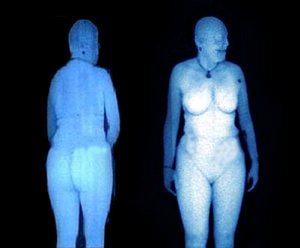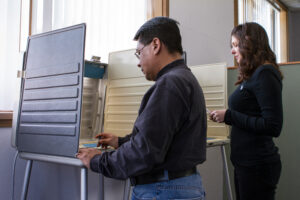Drive-By Scanning: Officials Expand Use and Dose of Radiation for Security Screening
In addition to the use of controversial airport body scanners, the US government now deploys various X-ray devices at the border, in prisons and on the streets of New York And some of them expose people to higher doses of radiation.
by Michael Grabell, ProPublicaThis piece originally appeared at ProPublica.
U.S. law enforcement agencies are exposing people to radiation in more settings and in increasing doses to screen for explosives, weapons and drugs. In addition to the controversial airport body scanners, which are now deployed for routine screening, various X-ray devices have proliferated at the border, in prisons and on the streets of New York.
Not only have the machines become more widespread, but some of them expose people to higher doses of radiation. And agencies have pushed the boundaries of acceptable use by X-raying people covertly, according to government documents and interviews.
While airport scanners can show objects on the surface of the body, prisons have begun to use X-rays that can see through the body to detect contraband hidden in cavities. U.S. Customs and Border Protection is in the process of deploying dozens of drive-through X-ray portals to scan cars and buses at the border with their passengers still inside.
X-ray scanners have been tested at ferry crossings, for visitor entries at the Pentagon and for long-range detection of suicide bombers at special events. And drawing the ire of privacy groups, Customs and the New York Police Department have deployed unmarked X-ray vans that can drive to a location and look inside vehicles for drugs and explosives.
Most federal health regulations for medical X-rays do not apply to security equipment, leaving the decision of when and how to use the scanners almost entirely in the hands of security officials.
Although the 9/11 attacks provided the impetus and prompted the spending to develop such equipment, most of the machines have been deployed only in the last few years. New attacks and ever-tighter security measures have made law enforcement officials more willing to expose the public to X-ray devices that were once taboo.
When the body scanners were introduced in prisons in the late 1990s, the Food and Drug Administration convened an advisory panel. Several of the outside scientists warned that once the longstanding practice of X-raying humans only for health reasons was ended, it was just a matter of time before the machines would become acceptable in airports, courthouses and schools.
“This is exactly what I was afraid was going to happen back when we had the FDA meetings,” said Kathleen Kaufman, who as director of Los Angeles County’s radiation management program served on the advisory panel.
The FDA has little authority to regulate the use of electronic products emitting radiation. Because security scanners are not classified as medical devices, the agency doesn’t approve them for safety before sale. And it can go after only the manufacturers for excessive radiation — not the users of the machines for deploying them too frequently or in other questionable ways.
Handicapping its power even more, the FDA ultimately went against the advisory panel’s recommendation to adopt a federal safety standard for the new security devices. Instead, it followed congressional direction to use industry standards wherever possible and let the scanners fall under voluntary guidelines set by a nonprofit group made up largely of manufacturers and agencies that wanted to use the X-ray machines.
It is difficult to estimate the long-term health risks of low levels of radiation. At higher levels, ionizing radiation — the energy used in the scanners — has been shown to damage DNA and mutate genes, potentially leading to cancer. A comprehensive study by the National Academy of Sciences concluded that the more radiation a person gets, however little at a time, the greater their lifetime risk of dying from cancer.
The manufacturers counter that their machines emit extremely low levels of radiation, hundreds of times less than a chest X-ray. Humans are constantly exposed to background radiation from radon in the ground and cosmic rays in the atmosphere. In comparison, the radiation from security devices is trivial, they say.
Moreover, the X-ray scanners have produced a number of success stories, intercepting immigrant smugglers, unearthing tons of cocaine and other drugs, preventing contraband in jails and adding a layer of protection to the nation’s transportation system, according to the agencies that use them.
But the rapid expansion raises serious questions about whether the United States is sacrificing safety in the name of security.
“Because of the wide proliferation of these things, we don’t know who’s using them and how frequently,” said Peter Rez, an Arizona State University physicist who has criticized the use of the machines. “It’s not that the radiation from these machines is very high. It’s ‘Does the benefit outweigh the risk?'”
X-rays on Wheels
One of the first technologies after 9/11 that would expose humans to X-rays was the Z Backscatter Van — essentially a x-ray scanner on a truck — made by American Science & Engineering.
The device, which was deployed by the military to detect car bombs in war zones, uses X-rays that are designed to find organic materials such as drugs and explosives. The rays scatter back to a detector rather passing through an object as in a medical X-ray. The van can scan while driving alongside a line of vehicles or while parked as they pass by.
According to a company presentation obtained by a civil liberties group, the Electronic Privacy Information Center (EPIC), a backscatter van delivers a radiation dose about twice that of an airport body scanner.
Soldiers serving in Iraq nicknamed the vans “white devils.” Customs officers call them “ice cream trucks .”
Customs and Border Protection has purchased 75 backscatter vans for use at border crossings, ports, Border Patrol checkpoints and even the Super Bowl, according to agency records. Customs spokeswoman Jenny Burke said passengers must exit the vehicle before the scan.
While the Transportation Security Administration hasn’t bought them, it tested them at a Delaware ferry crossing in 2004 and at a Long Island ferry crossing in 2009, spokesman Greg Soule said. In the first test, passengers weren’t in the vehicles. But in the second test, passengers remained in the vehicles but could opt out, he said. Another TSA test in 2009 was conducted in northern New Jersey on empty commuter train cars in a rail yard.
The X-ray vans have also shown up on American streets. In 2010, Homeland Security officials conducted an exercise scanning tractor-trailers on Interstate 20. And the New York Police Department uses the vans.
The NYPD has declined to release details about the use of the machines.
ABC News reporters Richard Esposito and Ted Gerstein provide one of the few accounts of the backscatter van in a book they wrote chronicling a year inside NYPD’s bomb squad. Describing the security ahead of President Bush’s motorcade to the 2004 Republican convention, they wrote that every vehicle entering the street in front of the hotel was ordered to drive between two unmarked white vans, which X-rayed each vehicle for bombs.
Such covert use of radiation, if done without informed consent, would violate the industry standard.
“The institution operating the system shall inform each person being screened that the system emits radiation,” the standard states. It also requires that people be told the radiation dose and that there be a visible indicator when X-rays are emitted.
Joe Reiss, AS&E’s vice president of marketing, said although the vans are designed for covert use, the vans comply with the standard because they have two lights that flash when a scan is in progress.
Kevin Barry, an NYPD bomb squad detective who retired in 2002, said that when he was there, the police ensured that the area was clear of people any time they used X-ray equipment and that officers wore film badges to monitor radiation exposure.
“They’re very cognizant of the fact that if there’s a radiation issue that they have to monitor the health issue,” he said.
But even if a violation were discovered, there is little the FDA can do because the standard is voluntary and not a federal regulation.
The FDA, which said it doesn’t regulate the “use” of security scanners emitting radiation, referred questions to New York State, which also said it does not regulate the scanners and referred questions to the New York City Department of Health, which also said it does not regulate the devices.
Drive-through Scanners
Customs and Border Protection is also installing 35 drive-through X-ray portals purchased with economic stimulus money, according to a company report posted on the government’s stimulus website, Recovery.gov.
A test system was installed at the San Ysidro border crossing in San Diego in 2008 and portals will soon be deployed in El Paso and Laredo, Texas, and elsewhere on the Southwest border, according to contract documents obtained by the privacy group EPIC.
The portals, made by AS&E, can scan cars and buses from the top and sides as their drivers pass through at 3 mph.
The scanners’ X-rays have to penetrate metal and glass. But according to Customs and the company, the radiation dose is equivalent to an airport body scan.
The dose is low because Customs officers do not need as high a resolution to see bulk explosives or drugs as a TSA screener would need to see a tiny detonator or a razor blade, said Rez, the Arizona State physicist. He estimated the dose by analyzing the images with a computer program.
The company says the portal is safe for everyday use. But Burke, the Customs spokeswoman, said it won’t be used on every driver crossing the border — only those who raise suspicion and require additional inspection. Passengers will be allowed to opt out and have a Customs officer drive it through the portal for them.
Ginger McCall, director of EPIC’s Open Government program, is skeptical.
“You know what else started out as a secondary screening mechanism?” she asked. “Airport backscatter machines. The TSA said ‘don’t worry’ to the American public. ‘These are only going to be used as secondary screening devices.’ And look how that turned out.”
“Intelligent Pedestrian Surveillance”
There are now about 250 X-ray body scanners in airports nationwide. But government agencies are exploring additional uses for the technology.
In 2010, the military brought two TSA body scanners to the Pentagon visitors’ entrance, where they were tested by Defense Department staff. But plans were put on hold pending TSA testing of new privacy software that wouldn’t show an image of a person’s body.
“There’s now technology which makes it look like a cartoon figure,” said Chris Layman, spokesman for the Pentagon Force Protection Agency. “We wanted to make sure that if we did this, all the privacy concerns are taken care of.”
The Department of Homeland Security has funded research for walk-through X-ray body scanners that could be used at special events, and for long-range X-ray scanners to detect suicide bombers in crowds, according to documents obtained by EPIC.
Using similar backscatter technology, the walk-through scanner would speed up checks that now require people to stand with their hands over their heads while scanned. In tests of the long-distance scanner, according to contract documents, officials wanted to see whether it could identify people with metal and dense plastic from up to 30 feet away.
“Customers need a greater capability than what is currently available for detecting IEDs on people,” Homeland Security officials wrote in a statement of work for a technology dubbed the “Intelligent Pedestrian Surveillance Platform.” “This is especially relevant at high-volume public areas and entrances to important infrastructure.”
The radiation dose for such a scanner was listed in 2006 as 10 times higher than that of an airport scanner.
Intelligence released last summer that terrorist groups are considering implanting bombs in their bodies has raised concerns that the TSA would one day deploy X-ray scanners that can see into the body. In the past, the agency has declined to say whether it had ever considered the technology, known as “transmission X-rays.”
But other Homeland Security documents, also obtained by EPIC and provided to ProPublica, show that in 2010, Homeland Security’s science and technology division entered into an agreement with the FDA to test such technology.
“Transmission X-ray devices are being considered by DHS for passenger screening,” the statement of work says. “The proposed use of transmission methods for routine passenger screening may have significant health & safety implications and requires special study and evaluation.”
John Verrico, a spokesman for the department’s science and technology division, said the proposed tests never went forward and the discussion of transmission X-rays was ultimately removed from the final statement of work.
“Transmission X-ray systems have not been tested,” he said in an email. “Personnel have viewed vendors’ demonstrations at their locations to evaluate the maturity of the equipment and the state of the technology.”
“Treating People Like Luggage”
Such machines, however, were introduced in prisons in 2011.
A transmission X-ray body scanner, the RadPRO SecurPASS, is sold by Virtual Imaging, a Florida subsidiary of Canon USA. In the last year, it has been installed at the Cook County Jail in Chicago; several jails in Florida and Alabama; and the Federal Transfer Center in Oklahoma City, a temporary detention center for inmates being transported across the country.
The dose has two settings. The standard setting delivers a radiation dose about 10 times higher than that of an airport body scanner. But to produce a better image, the operator has the ability to switch to a higher exposure, said Kris Kessler, creative marketing manager for Virtual Imaging.
That dose is still a fraction of the radiation received in a chest X-ray or cross-country flight. But it’s more than 50 times higher than that of an airport scanner.
Even with the standard setting, the quality of the image produced by the SecurPASS is so good that people don’t have to take off their jackets or shoes, as they do before going through the airport scanners, Kessler said.
“It’s almost like we’re treating people like luggage,” he said.
The device has already made some interesting finds. One inmate was found to have swallowed 10 pouches of heroin, Steve Patterson, then the Cook County Sheriff’s Office spokesman, told ProPublica last year. Another inmate, he said, was found to have kidney stones.
Jails use the SecurPASS mostly on prisoners as they leave and come back from work detail, Kessler said. But some facilities are considering using it on employees as well, he added, to prevent them from bringing in contraband.
Dennis Wolfe, Virtual Imaging’s national sales manager for security products, said he has had conversations with the TSA and that a test lasting several months was overseen by Homeland Security science and technology staff in 2010 and 2011. The department denied that.
The device, which was initially used to prevent theft in diamond mines, has already been used at London’s Heathrow Airport to scan suspected drug mules. (Customs officials in the United States and other countries can, with a traveler’s consent, order a medical X-ray, which would deliver a higher radiation dose.)
For now, however, Virtual Imaging is focusing on corrections facilities.
Chris Burke, a spokesman for the Federal Bureau of Prisons, said the system is running a pilot test of various scanners but has not made a decision.
Still, Wolfe said he expects many federal prisons and larger jail systems to be using the SecurPASS in the next few years. “It doesn’t take a rocket scientist,” he said. “If somebody’s hiding something up their butt, which technology are you going to use?”
The rapid growth of X-ray scanning for security and the limited authority granted to regulators make it difficult to keep track of the equipment.
Two airport body scanners, for example, were recently auctioned off by the General Services Administration. A new scanner typically sells for $170,000. But these scanners, which had been in storage, were sold for a total of $600.
Under FDA regulations, sellers would normally be required to keep records of who purchases their X-ray products. But because the FDA never adopted a mandatory safety standard for the airport body scanners, this rule does not apply.
To help determine the extent of the use of these devices, we’re seeking stories from those who have had personal experience. Please share your stories in a private email to [email protected].
We are especially interested in the following:
- Have you seen the NYPD backscatter vans? If so, where and how were they being used?
- Have you gone through a Z Portal at the border? What was your experience?
- If your car was scanned by a backscatter van by Customs or Border Patrol, were you asked to get out of the car or did you remain inside?
- If you work in a prison or jail with an X-ray body scanner, how are they used?
- Have you seen these technologies anywhere we didn’t mention in the story?
- Do you know of other security X-ray products that are being used or developed?
Any information is appreciated.
Your support matters…Independent journalism is under threat and overshadowed by heavily funded mainstream media.
You can help level the playing field. Become a member.
Your tax-deductible contribution keeps us digging beneath the headlines to give you thought-provoking, investigative reporting and analysis that unearths what's really happening- without compromise.
Give today to support our courageous, independent journalists.






You need to be a supporter to comment.
There are currently no responses to this article.
Be the first to respond.